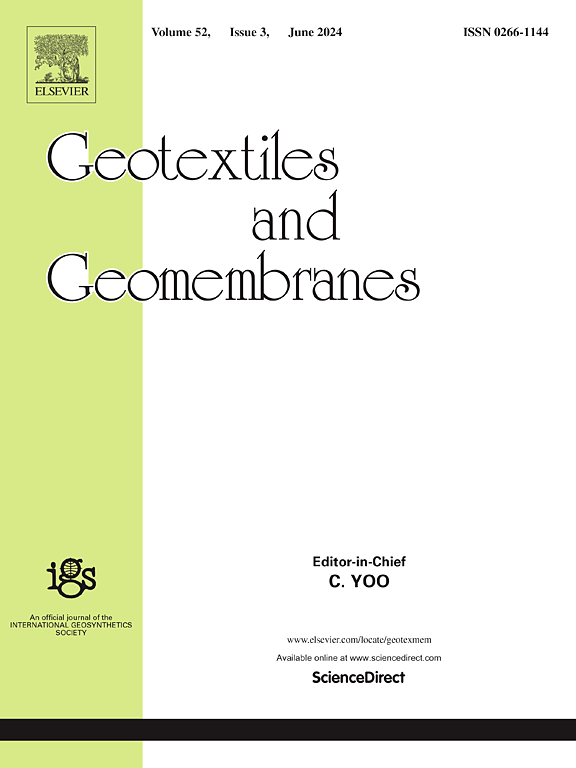试验速度对各类土工膜热力学性能的影响
IF 6.2
1区 工程技术
Q1 ENGINEERING, GEOLOGICAL
引用次数: 0
摘要
水工构筑物中的土工膜常处于暴露状态;环境温度变化很大,因此会影响它们的力学行为。为了确定它们在不同温度下的拉伸性能,单向拉伸试验可以在温控室中进行。然而,主要标准推荐的测试速度很高。考虑土工膜的弹粘塑性特性,试验速度具有双重效应;第一种来自粘性成分,第二种来自温度变化,这是由于测试过程中被测试样的自热造成的。本研究旨在通过解耦粘性效应和自热效应来研究测试速度对土工膜力学行为的影响。通过在0.01 mm/min ~ 500 mm/min较宽的试验速度范围内进行的各种单向拉伸试验,发现对于各种土工膜(HDPE、EPDM、PVC、FPO、沥青),试验速度越高,各应变水平下的拉伸力越大,试件内部温度变化越大。关于温度效应,结果表明,当测试速度小于或等于10 mm/min时,所有土工膜都没有观察到试样的自热现象。本文章由计算机程序翻译,如有差异,请以英文原文为准。
Impact of test speed on the thermo-mechanical behavior of various types of geomembranes
Geomembranes in hydraulic structures are often in exposed conditions; the ambient temperature can vary significantly and hence influence their mechanical behavior. To determine their tensile behavior at various temperatures, unidirectional tensile tests can be performed in temperature-controlled chambers. However, the test speeds recommended by the main standards are high. Considering the elasto-visco-plastic behavior of geomembranes, the test speed has a double effect; the first comes from the viscous component and the second comes from temperature variation, due to the self-heating of the tested specimen during test. This study aims to investigate the effect of the test speed on the mechanical behavior of various geomembranes by decoupling the viscous effect and the self-heating effect. Through various unidirectional tensile tests performed on a wide range of test speeds, from 0.01 mm/min to 500 mm/min, it was found that for various tested geomembranes (HDPE, EPDM, PVC, FPO, Bituminous), the higher the test speed, the greater the tensile force at various strain levels and the greater the change in internal temperature of the specimen. Regarding the temperature effect, it was shown that for test speeds less than or equal to 10 mm/min, no self-heating of the specimen was observed for all geomembranes.
求助全文
通过发布文献求助,成功后即可免费获取论文全文。
去求助
来源期刊

Geotextiles and Geomembranes
地学-地球科学综合
CiteScore
9.50
自引率
21.20%
发文量
111
审稿时长
59 days
期刊介绍:
The range of products and their applications has expanded rapidly over the last decade with geotextiles and geomembranes being specified world wide. This rapid growth is paralleled by a virtual explosion of technology. Current reference books and even manufacturers' sponsored publications tend to date very quickly and the need for a vehicle to bring together and discuss the growing body of technology now available has become evident.
Geotextiles and Geomembranes fills this need and provides a forum for the dissemination of information amongst research workers, designers, users and manufacturers. By providing a growing fund of information the journal increases general awareness, prompts further research and assists in the establishment of international codes and regulations.
 求助内容:
求助内容: 应助结果提醒方式:
应助结果提醒方式:


